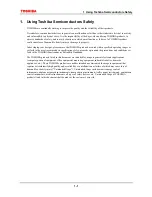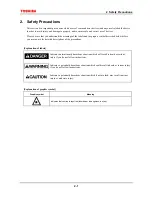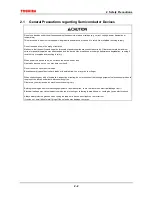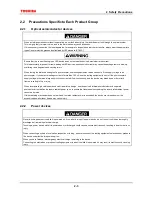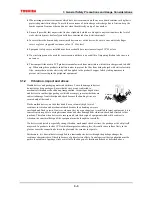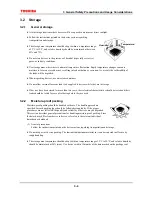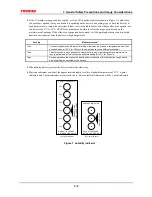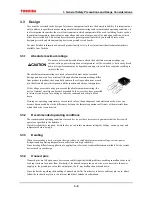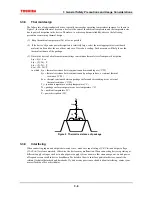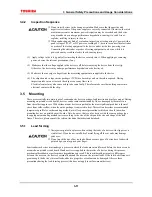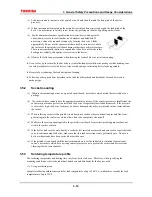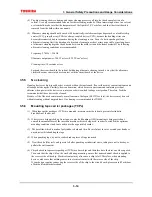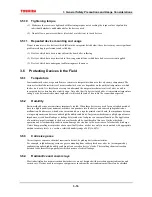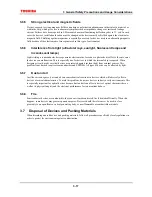
3 General Safety Precautions and Usage Considerations
3-7
CMOS logic IC inputs, for example, have extremely high impedance. If an input pin is left open, it can easily
pick up extraneous noise and become unstable. In this case, if the input voltage level reaches an intermediate
level, it is possible that both the P-channel and N-channel transistors will be turned on, allowing unwanted
supply current to flow. Therefore, ensure that the unused input pins of a device are connected to the power
supply (Vcc) pin or ground (GND) pin of the same device. For details of what to do with the pins of heat sinks,
refer to the relevant technical datasheet and databook.
3.3.5 Latch-up
Latch-up is an abnormal condition inherent in CMOS devices, in which Vcc gets shorted to ground. This
happens when a parasitic PN-PN junction (thyristor structure) internal to the CMOS chip is turned on, causing a
large current of the order of several hundred mA or more to flow between Vcc and GND, eventually causing the
device to break down.
Latch-up occurs when the input or output voltage exceeds the rated value, causing a large current to flow in the
internal chip, or when the voltage on the Vcc (Vdd) pin exceeds its rated value, forcing the internal chip into a
breakdown condition. Once the chip falls into the latch-up state, even though the excess voltage may have been
applied only for an instant, the large current continues to flow between Vcc (Vdd) and GND (Vss). This causes
the device to heat up and, in extreme cases, to emit gas fumes as well. To avoid this problem, observe the
following precautions:
(1) Do not allow voltage levels on the input and output pins either to rise above Vcc (Vdd) or to fall below
GND (Vss). Also, follow any prescribed power-on sequence, so that power is applied gradually or in steps
rather than abruptly.
(2) Do not allow any abnormal noise signals to be applied to the device.
(3) Set the voltage levels of unused input pins to Vcc (Vdd) or GND (Vss).
(4) Do not connect output pins to one another.
3.3.6 Input/Output
protection
Wired-AND configurations, in which outputs are connected together, cannot be used, since this short-circuits the
outputs. Outputs should, of course, never be connected to Vcc (Vdd) or GND (Vss).
Furthermore, ICs with tri-state outputs can undergo performance degradation if a shorted output current is
allowed to flow for an extended period of time. Therefore, when designing circuits, make sure that tri-state
outputs will not be enabled simultaneously.
3.3.7 Load
capacitance
Some devices display increased delay times if the load capacitance is large. Also, large charging and discharging
currents will flow in the device, causing noise. Furthermore, since outputs are shorted for a relatively long time,
wiring can become fused.
Consult the technical information for the device being used to determine the recommended load capacitance.
Summary of Contents for TMPR4925
Page 1: ...64 Bit TX System RISC TX49 Family TMPR4925 Rev 3 0 ...
Page 4: ......
Page 15: ...Handling Precautions ...
Page 16: ......
Page 18: ...1 Using Toshiba Semiconductors Safely 1 2 ...
Page 40: ...3 General Safety Precautions and Usage Considerations 3 18 ...
Page 42: ...4 Precautions and Usage Considerations 4 2 ...
Page 43: ...TMPR4925 ...
Page 44: ......
Page 54: ...Chapter 1 Features 1 8 ...
Page 58: ...Chapter 2 Block Diagram 2 4 ...
Page 88: ...Chapter 4 Address Mapping 4 12 ...
Page 226: ...Chapter 8 DMA Controller 8 58 ...
Page 260: ...Chapter 9 SDRAM Controller 9 34 ...
Page 480: ...Chapter 15 Interrupt Controller 15 32 ...
Page 554: ...Chapter 19 Real Time Clock RTC 19 8 ...
Page 555: ...Chapter 20 Removed 20 1 20 Removed ...
Page 556: ...Chapter 20 Removed 20 2 ...
Page 564: ...Chapter 21 Extended EJTAG Interface 21 8 ...
Page 580: ...Chapter 22 Electrical Characteristics 22 16 ...
Page 588: ...Chapter 24 Usage Notes 24 2 ...



